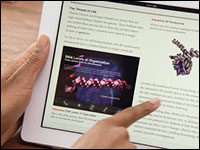
Not so long ago, Motorola was hailed as the bane of criminals. “You might outrun the cop, but you’ll never outrun Motorola,” went the saying. The Motorola two-way radio was one of the first technologies to tip the scales in favor of law enforcement. However, it was by no means the last.
“Today, it’s all about pulling in multimedia at the edge, fusing it with data streams in the command center, and then pushing out the combined intelligence to the field officers in real-time,” Kevin McDunn, director of strategy at Motorola, told TechNewsWorld.
Full Exposure
The data streams in the command center can be anything from outstanding warrants, previous call notes, arrest records, alerts, information on gangs that populate the area, to photographs of suspects or suspected victims. The multimedia “on the edge” can be real-time video from public or private surveillance cameras or even photos or video from a witness’ cellphone.
There are numerous third parties developing an array of cop tools and apps that can funnel into such a command center. Take, for instance, ShotSpotter, the technology that triangulates the location of a gunshot using a maze of public microphones and sophisticated audio analytics.
Or, LexisNexis’ Link ID, a data-linking and analysis technology that helps law enforcement agencies make faster, more informed decisions by connecting data from billions of records and more than 10,000 data sources within seconds.
“As a result, police officers and investigators can obtain a complete picture of an individual in order to quickly and efficiently locate people, uncover assets, perform due diligence and prevent, detect and investigate fraud,” Haywood Talcove, chief executive officer of LexisNexis Special Services, told TechNewsWorld.
Virtual Eyewitness and Technical Backup
Real-time — and often urgent — critical information can flow quickly to a command center from the field as well. For example, an officer can trigger “virtual backup” with the push of a single emergency button on his radio unit.
“The emergency button is equipped with GPS and from that locator, the command system can immediately turn to cameras in the vicinity,” said Motorola’s McDunn. “That way, units on their way to assist the officer can see what’s happening as it happens.”
The virtual backup also provides evidence for court.
“Use of video analytics is the wave of the future,” Dilip Sarangan, security analyst for Frost & Sullivan, told TechNewsWorld. “The video is catalogued, archived and searchable. The days of painstakingly looking through hours of footage are over.”
Analytics can also detect any footage tampering and track the chain of custody — noting exactly who has accessed the evidence and when.
Video analytics is coming up next for the newly unveiled PremierOne — an integrated system for law enforcement command centers that Motorola built on Microsoft’s .Net technology, McDunn said. For now, PremierOne is designed to coordinate and integrate dispatch records, mobile communications and CSRs (customer service requests intended to manage 311 centers and field responses to work orders).
“Motorola invested in Microsoft to build the system from the ground up, rather than just wrap something around Microsoft .Net,” explained McDunn. “We even hired Microsoft architects and engineers to ensure PremierOne has no glitches and meets public safety’s stringent requirements of complete reliability.”
Motorola put extra effort in the UI to make sure law enforcement could easily use the system in the field, even under high stress situations, he noted.
Nixle Nixes Crime
The Ventura Police Department helped with testing the system and received a sizable discount for doing so. However, PremierOne isn’t the only thing Ventura-area law enforcement agencies are taking for a test run.
The Ventura County Sherriff’s Department recently used Nixle, a Twitter-like tool that pushes out mass text messages, emails, and Web postings, to issue brush-fire evacuation alerts and coordinate with first responders.
The Pittsburgh Bureau of Police also recently used Nixle.
“Before Nixle, we never had a secure internal communications tool,” said Pittsburgh Chief of Police Nathan Harper.
“Covering a world event such as G20 requires multiple agencies to work in coordination with one another. Nixle allows for seamless communication — we’re sending G20 updates in real-time to every officer in the field,” he said.
“Unlike radio, it’s an authenticated secure communication system on one standardized platform,” explained Harper. “This is paramount for officers to effectively do their job. Nixle allows all of us to stay on the same page.”
Predictive Sleuthing and Preventive Action
The Edmonton Police Service uses IBM Cognos 8 Business Intelligence software to predict crime and cut it off at the pass.
“We want to know what crime is happening where and when is it happening, so we can apply that analytical information to our frontline people to give them a head start in where they can be to catch the bad guys,” John Warden, staff sergeant and BI team lead, Edmonton Police Service, told TechNewsWorld.
The IBM analytics technology enabled the department to detect an upward trend in crime, he said. Based on the instant information made available through analytics and a comparison with data from previous years, the Edmonton police were ultimately successful in nearly eliminating arsons in their area by knowing when to watch.
“For us, the bottom line is to prevent crime, and business analytics reporting has helped us accomplish that,” said Warden.
IBM is working with the New York City Police Department to research crime trends and produce reports through the Crime Information Warehouse (CIW). The solution allows officers and analysts to detect crime patterns as they are forming, enabling precinct commanders to take proactive measures to stay ahead of these trends.
Meanwhile, IBM and the City of Chicago’s Office of Emergency Management and Communications (OEMC) have implemented one of the most advanced city-wide intelligent security systems as part of Chicago’s Operation Virtual Shield, a project that encompasses one of the world’s largest video security deployments.
When the Cop’s Sidekick Is a Car
One of the best tools a cop can have at hand is his patrol car. Besides helping cops chase down the bad guys, the car can become an extension of the officer himself — that is, if it’s a second-generation high-tech model.
The Carbon Motors E7, designed by the Georgia Tech Research Institute and slated for production in 2012, features an ergonomic “cockpit” designed to help drivers safely and efficiently interact with the vehicle under high-stress conditions. It features a large touchscreen with voice-activated controls and a backup manual system.
Beyond its cop-perfect user interface, the car has an automatic license plate reader, a radiation detector and night-vision capabilities, as well as other crook-catching aids.
The Carbon Motors E7 is being billed as the world’s first “purpose-built” law enforcement vehicle. Criminals may have gotten smarter, but so have the cops.






















































